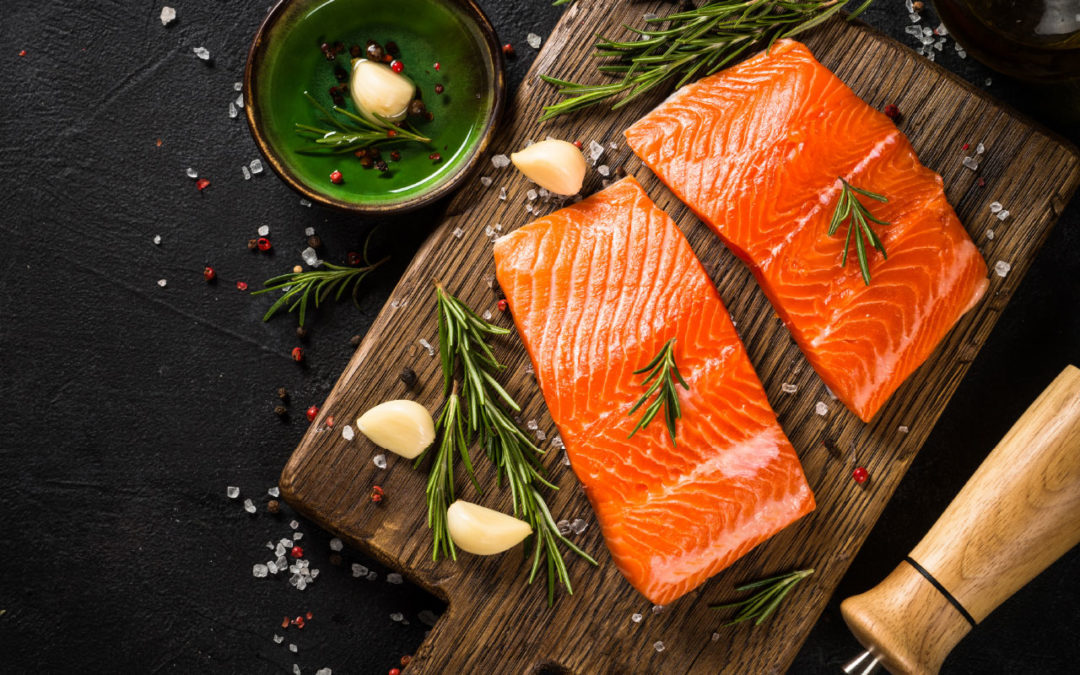
By Kirsten Serrano
The pandemic has changed the way we eat, and some of those changes have been for the better. One notable change is that we are eating more seafood at home. In December 2020, fresh and frozen seafood sales were up about 25% from a year before.1 Before the pandemic, Americans ate seafood when dining out and rarely prepared it at home. An astonishing 70% of seafood was purchased from restaurants. When restaurants closed, seafood consumption bottomed out. As the pandemic wears on, more of us are including seafood in our cooking at home. Seafood consumption is still down overall, but we need to keep up our new seafood-at-home habit even when restaurants are fully open. The health benefits of seafood are too big to pass up.
Nutritionally, seafood is a powerhouse. Nutrient dense and easy to digest, seafood has more going for it than I can sum up in one column, so I am going to focus on one major benefit. Let us take a look at how the fats in seafood affect our health.
Seafood is full of Omega 3 fats
You have likely heard of Omega 6 and Omega 3 fatty acids. We need both, but we need them in a healthy ratio. An ideal fatty acid ratio of essential omega fatty acids 6:3 falls between 1:1-3:1. The estimate is that the standard American diet is about 15:1, but I have seen estimates that it is as high as 40:1. This imbalance is a national emergency. Looking at the chart on the following page, it is easy to think of Omega 6 as bad and Omega 3 as good, but that is an oversimplification. Inflammation, constriction and pain are important bodily functions. Problems ensue when the Omega 6:3 ratio is out of balance. Too much Omega 6 in the diet can contribute to cancer, heart disease, diabetes, obesity, mental disorders and more.2 If the pandemic has taught us anything, it is that we want to reduce inflammation and have a strong immune system. Increasing seafood in our diet goes a long way in correcting our Omega 6 to 3 ratio and sets us up for better physical and mental health.

Some of the richest sources of Omega 3 fats are salmon, anchovies, sardines, oysters, tuna, mackerel and squid. Salmon is so rich that it can have 100 times more Omega 3 fats than beef.3 I recommend eating seafood at least 4 times a week. The common hurdles to eating more seafood at home are price, knowledge about selecting/preparing it and availability. Here are some tips for overcoming these hurdles and harnessing the power of seafood:
Price. Stock up on canned seafood. Nothing beats the convenience, shelf-stability and price point of canned fish. Canned seafood turns into easy meals. Tip: Only buy seafood packed in water or olive oil. Seed oils are high in Omega 6.
Selection: Sustainability and quality matter. We need to eat more seafood and make sure it is around to eat in the future. Consult an online guide to seafood sustainability like Seafood Watch from the Monterey Bay Aquarium.
Preparation: If cooking seafood is overwhelming, focus on getting good at one method. Seafood is very easily baked or broiled. The trick is that seafood cooks much more quickly than other meats so look up what temperature to cook it to and use a meat thermometer to check frequently.
Availability: If your concern is about how fresh your seafood is, know that frozen is often the best option. A lot of seafood is flash frozen right on the boat at peak quality and is the better option. Fresh farmed options are often a great choice too. Farming operations vary in quality so refer to a guide like Seafood Watch to help. If you are not seeing the items you want at a local grocer (especially for those of us that are landlocked), shop online. Like everything else, buying seafood online is an ever-increasing option.
Kirsten Serrano is a nutrition consultant, chef, farmer, food literacy educator, and the best-selling author of “Eat to Your Advantage.” You can find out more about her work at SmallWonderFood.com.
References:
1 Pomranz, Mike. “More Americans Appear to Be Cooking Seafood at Home due to the Pandemic.” Food & Wine, 25 Jan. 2021, www.foodandwine.com/news/americans-buying-more-seafood-pandemic. Accessed 6 Feb. 2021.
2 Robinson, Jo. “Eat Wild – Health Benefits.” Eat Wild, 2019, www.eatwild.com/healthbenefits.htm. Accessed 1 Jan. 2020.
3 McGee, Harold. “Grass-Fed Beef vs. Farmed Salmon.” Curious Cook, 6 Nov. 2006, www.curiouscook.com/site/2006/11/grass-fed-beef-vs-farmed-salmon.html#:~:text=The%20long%2Dchain%20omega%2D3s. Accessed 7 Feb. 2021.










